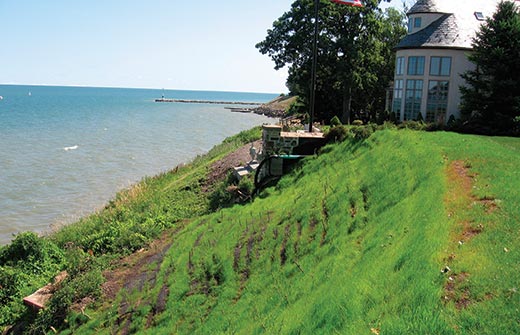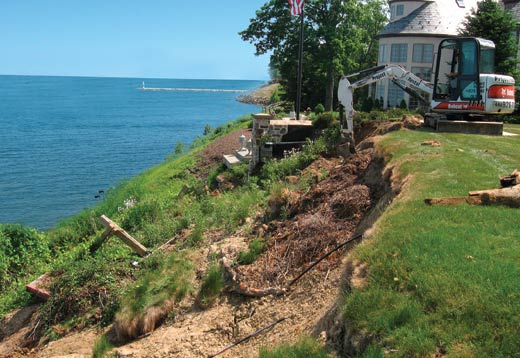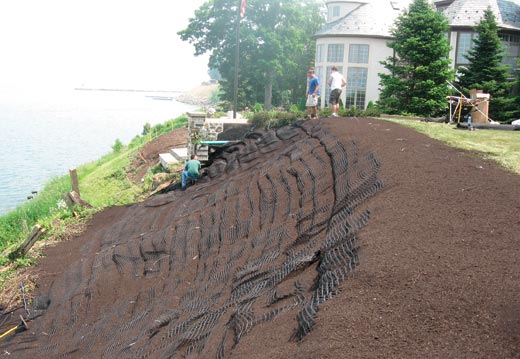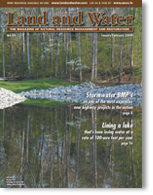Features Available Online
The Edge of Paradise
Preserving America’s Home sites from Erosion
Above (after): The Living Wall stabilized the eroding slope and gave homeowners the “green” they desired. Below (before): A mini excavator removes the top lip of the 1:1 slope, reshaping it to a manageable 2:1 slope.

Introduction
“ALL the easy to develop construction sites are gone”. How many times have you heard that? Well, the counterpart is that some of the older development areas, including those on or near lakes, are suffering the effects of longtime erosion and it is now jeopardizing their survival along the shores. All of the great lakes, the ocean states, and other large lakes have issues with real estate falling into the water or eroding from the top down.
The main difference here is the type of erosion. Overland flow causes different damage than that of erosion by wave action at the foot of these properties. Although wave action is a challenging issue, this article focuses on curing the overland erosion problem from ‘the top down’. Historically, most have used block retaining walls, with geogrid tie backs that have been solid when installed correctly, however, they have not met the ‘green’ requirements that some customers like.
The owners of these properties, many with homes built between 1880 and 1950, are frustrated after losing several feet of their backyards and are looking for solutions. In the case of the McFadden’s, of Rocky River, Ohio, their concern peaked when their former retaining wall partially fell into Lake Erie. The McFadden’s researched the topic on wall structures, holding capacity, ability to be ‘green’ and other factors. Their search produced options ranging from $20 per square foot to over $100 per square foot and included block walls/gabions/other hard structures as well as the Filtrexx Reinforced Living Wall.
The previous wall system at the McFadden’s was a typical wood tie wall, installed about 15 years ago. Due to recent failure, Mr. McFadden began discussions with Nick Strazar, from Certified Erosion Control, a local installer for Filtrexx products. “We reviewed the project and made sure that the problem was not caused by wave action”, says Strazar. “The property actually is perched about 20 feet above the lake, on a shale shelf, so it is really pretty stable. But the erosion of the slope to and over that shale shelf was cause for concern,” he said.
Strazar selected the Living Wall System, which is an erosion control tube or a combination of geogrid and compost filled ‘Soxx’ which help increase germination of the nurse crop of vegetation. “If you see their backyard, it is like a paradise of beautiful landscape plants, and then there is this mess of a wall system that failed. So the system allows us to blend in with nature more and the design actually mimics nature closer than anything else we have seen on the market,” said Strazar.
To restore the ‘garden of Eden’ at the McFadden’s, Strazar and crew had to work within the following guidelines: limit damage on existing plants; due to access use only small power tools; safety issues on steep slopes; rapid establishment of plants was due to time of year; and use vegetation to simulate parts of the rest of the slope that has not yet failed, which included grasses, ivy and willows.

The tubes were installed in combination with a geotextile wrap. The grid allows the tubes to be encased in a support structure, while vegetation comes out through the grid.
Project review
The project began with a mini excavator removing the top lip of the 1:1 slope, reshaping it to a manageable 2:1 slope. By removing the lip and laying the slope back, the fill was used to level the areas below the steep lip and repair some of the existing erosion. Once the site grading was finished, installation of the erosion control tubes was undertaken.
The tubes were installed in combination with a geotextile wrap from Checkmate Geosynthetics. The grid allows the tubes to be encased in a support structure, while vegetation planted come out through the grid. The result is a root, soil and grid mixture that strengthens the slope and reduces the chance for erosion or a slide. The first tubes installed were at the bottom, keyed into the slope and then continually installed up the slope to the top. Each layer was staked and wrapped where required, with the geogrid. Duckbill anchors were driven to a depth of about 3-4 feet to hold the geogrid in place every few feet. “It was challenging to drive these anchors into this steep slope,” said Strazar. “It is hard to lift an 80 pound jackhammer above your head to get it to drive in a 4 foot rod into the ground that sets the Duckbill wire,” he said. The jackhammer was needed because manual labor to drive the anchors would have taken days. It was common to hit rock and other debris that had fallen into the slope over the years.
Once the tubes were completed the area was topdressed with compost and planted with live stakes. Streamco willows were used along with perennial rye seeded right in the tubes. The live stakes were cut at an angle and pushed easily right into the soxx and then into the slope beneath them. Composted ‘growing media’ was used as the filler material to ensure quick establishment of the vegetation. Tests at Filtrexx laboratories three years ago indicated a 95% survival rate using the specially designed irrigation system included with this installation. Planting can include plugs, sprigs, seeds or live stakes and most plants grow well in compost or high organic soil mixes. The compost used with the system provides the ideal soil requirements as ‘fertile, well drained soil’, along with the structural component for stability.
In order to properly design this project, Strazar took advantage of a new division of the manufacturing company that helps create custom designs. “We could have done a number of trial and error things on this job or we could hire a professional to help us design it and to it right the first time,” said Strazar.
“Our job is to work ourselves out of a job on these types of projects,” said Alex Marks, General Manager of Filtrexx International. “Once these projects are completed, we aren’t needed to provide as many designs because the installers are generally more familiar with what is required,” said Marks.
One of the chief concerns for any project is water required for germination and establishment. “Part of our technology for wall systems is to make sure we can provide water even in the hottest months,” said Marks. “A lot of streambanks and wall work like this may stop in the heat of the summer. We are able to install irrigation in each of the tubes so you can work the entire summer,” he said. The irrigation was a crucial component in the successful establishment of the first wave of vegetation for this project due to the drought in the Cleveland area this summer.
In order to comply with current drainage issues, the installation was done in coordination with the addition of slope drains and 4” pvc drainage pipe, in order to move surface water and downspout water into and through the wall system.
Costs for the project utilizing the Living Wall were about 20% less than quotes for a traditional block wall, while also minimizing the potential for to damages to the existing landscapes.
As new products are developed to address the needs of erosion control on steep slopes, these tools in current designs can provide unique opportunities for new construction.![]()
For more information, contact Rod Tyler at Filtrexx International LLC, 35481 Grafton Eastern Rd., Grafton, OH 44044, (440)926-8041 or e-mail: rodt@filtrexx.com.

